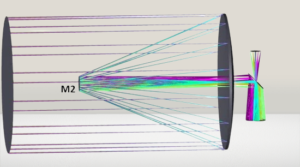The Europe Space Telescope as of late confronted a basic issue when its sight was darkened by ice development. Nonetheless, because of an effective de-icing method, its vision has been reestablished, featuring the critical job of upkeep in space investigation.

This article investigates the difficulties faced by the European space telescope, the technique used to reestablish its sight, and the meaning of this occasion for the field of cosmology.
Outline of the De-icing Methodology
The de-icing method for the European Space Telescope was a basic activity that elaborated a few complex moves toward re-establishing the telescope’s sight. The technique started with the location of ice development on the telescope’s outside, which was distinguished through a blend of installed sensors and ground-based perceptions. When the ice development was affirmed, a group of specialists and experts fastidiously arranged the de-icing methodology to guarantee its prosperity.
The initial step of the de-icing method included the sending of specific hardware to the telescope’s area in space. This gear included automated arms with de-icing instruments, which were utilized to painstakingly eliminate the ice from the telescope’s surface. The mechanical arms were controlled from a distance from a mission control focus on the planet, where specialists observed the advancement of the de-icing activity continuously. As the mechanical arms attempted to eliminate the ice, the telescope’s frameworks were briefly closed down to keep any harm from the system.
This necessary exact coordination between the de-icing group and the telescope’s administrators to guarantee that the closure was directed securely and proficiently. When the ice was taken out, the telescope’s frameworks were steadily restarted to bring it back on the web. Designs painstakingly observed the telescope’s exhibition during this interaction to guarantee that it was working accurately. After a progression of tests and checks, the telescope was proclaimed completely functional, with its sight completely re-established.
By and large, the de-icing methodology was a mind-boggling testing activity that expected cautious preparation and execution. Nonetheless, because of the ability and commitment of the de-icing group, the Europe Space Telescope’s vision was effectively reestablished, permitting it to proceed with its central goal of investigating the universe.
Challenges Looked by the Telescope
The Europe Space Telescope confronted a few difficulties connected with the ice development that clouded its sight. One of the fundamental difficulties was the location of the ice development itself. The telescope is situated in a distant area in space, making it challenging to examine for ice development outwardly.
All things considered, engineers needed to depend on locally available sensors and ground-based perceptions to identify the ice, which required exact coordination and correspondence between the telescope’s administrators and the ground-based group. When the ice development was recognized, another test was deciding the best way to deal with eliminating it. The telescope is a complicated piece of hardware with sensitive parts, so eliminating the ice without causing any damage was pivotal.

Engineers needed to painstakingly consider factors, for example, the temperature of the ice, the kind of de-icing apparatuses to utilize, and how much power to apply to the telescope’s surface. Another test was the effect of the ice development on the telescope’s exhibition.
The ice might have impacted the telescope’s capacity to precisely catch pictures and information, which might have undermined its central goal. It was fundamental to reestablish the telescope’s sight rapidly to limit any interruption to its activities.
By and large, the difficulties looked at by the Europe Space Telescope were critical, however because of the aptitude and commitment of the de-icing group, they effectively survived. The fruitful reclamation of the telescope’s sight shows the significance of proactive upkeep and the flexibility of room investigation innovation.
https://www.youtube.com/watch?v=tl1B6wpnx_I
Significance of Reestablishing Sight to the Telescope
The rebuilding of sight to the European Space Telescope is of fundamental significance in light of multiple factors.
First and foremost, the telescope assumes an urgent part in propelling comprehension we might interpret the universe. Furnished with cutting-edge instruments it catches natty gritty pictures of far-off systems, stars, and other heavenly articles. Without clear sight, the telescope would not be able to satisfy its logical targets, obstructing our capacity to study and find out about the universe. Besides, the reclamation of the telescope’s sight exhibits the versatility of room investigation innovation.
Space telescopes work in unforgiving conditions, presented with outrageous temperatures and astronomical radiation. The way that the Europe Space Telescope had the option to conquer the test of ice development and proceed with its central goal features the heartiness of its plan and the expertise of the specialists and professionals who keep up with it.
Thirdly, the rebuilding of sight to the telescope is a demonstration of the significance of proactive upkeep in space investigation. Normal support and assessments are fundamental to guarantee that space telescopes stay in ideal condition and can keep on working. The effective de-icing technique fills in as a sign of the basic job that upkeep plays in the outcome of room missions.
Specialized Subtleties of the De-icing System
The de-icing strategy for the European Space Telescope included a few specialized moves toward securing and eliminating the ice development. The strategy started with the sending of mechanical arms outfitted with de-icing apparatuses to the telescope’s area in space. These mechanical arms were controlled from a distance from a mission control focus on the planet, where specialists checked the advancement of the de-icing activity.
The de-icing apparatuses utilized by the automated arms were explicitly intended to eliminate ice from the telescope’s surface without bringing about any harm. These apparatuses included brushes, scrubbers, and intensity producers, which were utilized in a blend to separate and eliminate the ice. The automated arms had the option to arrive at all pieces of the telescopes outside, guaranteeing that the ice development was taken out.
As the automated arms worked, the telescope’s frameworks were briefly closed down to forestall any harm. This expected cautious coordination between the de-icing group and the telescope’s administrators to guarantee that the closure was directed securely. When the ice was eliminated, the telescope’s frameworks were steadily restarted, and designs checked its exhibition to guarantee that it was working accurately.
One of the critical difficulties of the de-icing strategy was guaranteeing that the automated arms could work successfully in the brutal climate of the room. The arms must have the option to endure outrageous temperatures and vast radiation, as well as work with accuracy to try not to harm the telescope.
Effect of the Strategy on Telescope’s Presentation
The effective de-icing strategy fundamentally affected the Europe Space Telescope’s exhibition. Preceding the methodology, the telescope’s vision was clouded by ice development, which frustrated its capacity to catch clear pictures of heavenly items. This restricted its logical capacities and undermined its capacity to satisfy its main goal targets. After the ice development was eliminated, the telescope’s exhibition improved emphatically. It had the option to catch clear, point-by-point pictures of far-off worlds, stars, and other divine articles, permitting researchers to concentrate on them more meticulously.

This has prompted new disclosures and experiences into the idea of the universe, encouraging comprehension we might interpret its beginnings and advancement. As well as working on its logical abilities, the de-icing technique additionally expanded the telescope’s functional life expectancy.
By eliminating the ice development, the methodology assisted with forestalling harm to the telescope’s delicate instruments and parts, guaranteeing that it can keep on working actually for quite a long time into the future.
In general, the effect of the de-icing methodology on the Europe Space Telescope’s exhibition has been predominantly certain. It has re-established the telescope’s capacity to catch clear pictures of the universe, facilitating how we might interpret the universe and broadening the telescope’s functional life expectancy.
Conclusion
All in all, the effective de-icing methodology used on the European Space Telescope has reestablished its sight as well as featured the significance of proactive support in space investigation. The difficulties confronted and defeated during this activity exhibit the strength and refinement of room innovation, as well as the commitment of the groups in question.
The reestablished usefulness of the telescope is preceded by the investigation of the universe, preparing for new disclosures and headways in how we might interpret the universe. This occasion fills in as a sign of the basic job that support plays in guaranteeing the outcome of room missions and the proceeding development of human information past Earth’s limits.
